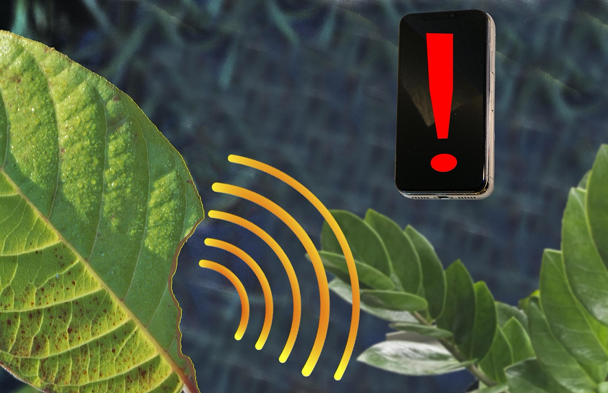Apr 17 2020
Scientists have developed a new method through which the internal interaction of living plants can be studied and monitored using carbon nanotube sensors that are integrated into plant leaves.
 Nanosensors implanted within plant leaves can send signals that communicate the stress-induced signaling pathways of plants to a smartphone. Image Credit: Felice C. Frankel.
Nanosensors implanted within plant leaves can send signals that communicate the stress-induced signaling pathways of plants to a smartphone. Image Credit: Felice C. Frankel.
The team included scientists from Massachusetts Institute of Technology (MIT), Temasek Life Sciences Laboratory (TLL), and Singapore-MIT Alliance for Research and Technology (SMART)—MIT’s research enterprise based in Singapore.
The carbon nanotube sensors can report the signaling waves of plants to show how they react to different types of stress such as heat and light damage, injury and infection, and, therefore, provide useful and real-time insights for cultivating the plants to boost crop yield.
This latest nanobionic method has been described in a study titled “Real-time Detection of Wound-Induced H2O2 Signalling Waves in Plants with Optical Nanosensors” and was also published in Nature Plants, a renowned online scientific journal.
In this method, sensors are used to detect the hydrogen peroxide signals that are used by plants to interact internally, and subsequently display the information on remote electronic devices such as cell phones. This approach enables agricultural researchers to remotely monitor the health of plants in real-time.
Plants have a very sophisticated form of internal communication, which we can now observe for the first time. That means that in real time, we can see a living plant’s response, communicating the specific type of stress that it’s experiencing.
Michael Strano, Co-Lead Principal Investigator, Disruptive & Sustainable Technologies for Agricultural Precision, SMART
Disruptive & Sustainable Technologies for Agricultural Precision (DiSTAP) is an Interdisciplinary Research Group under SMART. Professor Strano is the study’s senior author and also a Carbon P. Dubbs Professor of Chemical Engineering at MIT.
The latest technology can offer the much-needed information to analyze the reaction of different species of plants to pathogens, or to inform an array of agricultural applications such as screening different species of plants for their potential to tolerate different types of stress, including heat, light, and mechanical damage. The technology can even be used for analyzing the response of the plants in urban farms to different growing conditions.
Plants that grow at high density are prone to shade avoidance, where they divert resources into growing taller, instead of putting energy into producing crops, lowering overall crop yield. Our sensor allows us to intercept that stress signal and to understand exactly the conditions and the mechanism that are happening upstream and downstream in the plant that gives rise to the shade avoidance, thus leading to fuller crops.
Michael Strano, Co-Lead Principal Investigator, Disruptive & Sustainable Technologies for Agricultural Precision, SMART
Conventionally, molecular biology research has been restricted to just a certain group of plants that are responsive to genetic manipulation, but the latest technology developed by the research team can possibly be used on any variety of plant.
Professor Strano’s research team has already used this method effectively to compare eight different species such as arugula, strawberry plants, and spinach, and it is believed that the same approach may also work for many more species.
The study was financially supported by the U.S. Department of Energy Computational Science Graduate Fellowship Program, the National Research Foundation (NRF) Singapore, and the Agency for Science, Technology and Research (A*STAR). It set out to integrate the sensors into plants that would report back about the health status of the plants.
Using a technique known as lipid exchange envelope penetration (LEEP), which was previously devised by Professor Strano’s laboratory, the researchers successfully integrated the sensors into the plant leaves.
I was training myself to get familiarized with the technique, and in the process of the training I accidentally inflicted a wound on the plant. Then I saw this evolution of the hydrogen peroxide signal.
Tedrick Thomas Salim Lew, Study Lead Author and Graduate Student MIT
When hydrogen peroxide is discharged, it mediates the release of calcium among the neighboring plant cells, activating them to discharge more amounts of hydrogen peroxide and also producing a wave of distress signals along the plant leaves. The hydrogen peroxide wave triggers the plants to create secondary metabolites that can aid in repairing the damage. Such metabolites are usually the source of the flavors desired in edible plants.
Exploiting this mechanism can help farmers to improve the taste of the plants that are consumed by people and, at the same time, allow them to maximize the crop yield.